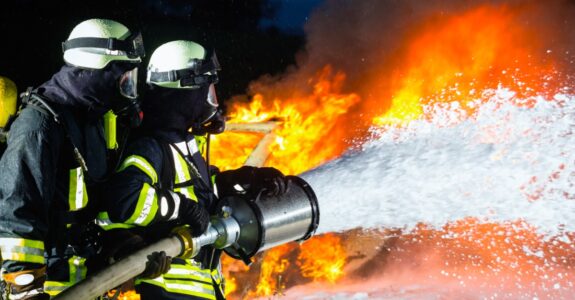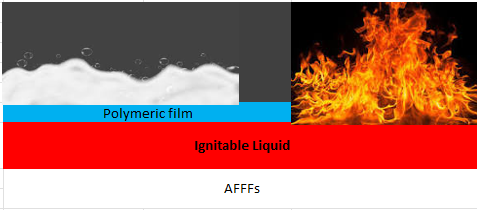
Transitioning from PFAS Firefighting Foam to Fluorine-Free Alternatives
September 27, 2023
By: Steve Pepper, MS, CSP
AFFF Treatment
Firefighting foams have long been an essential tool for firefighting agencies and industrial emergency services worldwide, providing a rapid and effective means to suppress fires, particularly those involving ignitable liquids. For years, the industry has favored Aqueous Film Forming Foams (AFFF) that contain per- and polyfluoroalkyl substances (PFAS), mainly due to their heat resistance combined with oil-repelling properties. However, growing concerns over the environmental impact and potential health risks of PFAS has led to a shift towards synthetic fluorine-free foams (SFFFs). This transition isn’t a simple swap – it’s a reevaluation of firefighting strategies, equipment, and training. These growing environmental and health concerns have led to a global shift towards fluorine-free firefighting foam. Here, we will explore the reasons behind this transition and highlight the benefits of adopting fluorine-free alternatives. Stay on the lookout for future information about human health effects of PFAS, environmental fate and transport, and strategies for an effective transition to SFFFs.
Understanding PFAS Concerns
Per- and polyfluoroalkyl substances (PFAS) are a group of man-made chemicals that have been widely used since the mid-20th century. They are incredibly stable, heat-resistant, and repel both water and oil, making them useful in a wide range of applications, including firefighting foams.
However, PFAS are known as ‘forever chemicals’ due to their persistent nature and accumulation in the environment, including water sources as well as in the bodies of humans and wildlife. Some PFAS have been linked to adverse health effects such as changes in liver function, decreased fertility, and an increased risk of certain cancers.
The Need for Fluorine-Free Alternatives
Recognizing the environmental and health risks associated with PFAS foam, manufacturers and firefighting agencies are transitioning to fluorine-free alternatives. These new foams are designed to provide effective fire suppression without PFAS chemicals in their formulation. By eliminating PFAS, we can significantly reduce the potential for long-term environmental contamination, protect water sources, and safeguard the health of both firefighters and the communities they serve.
Transitioning to Fluorine-Free Foams
Synthetic Fluorine-Free Foams (SFFFs) are formulated without the use of PFAS, reducing the potential impact on both the environment and human health.
SFFF foams are not just PFAS-free versions of AFFFs; they are fundamentally different in their approach to fire suppression. AFFFs work by creating a thin aqueous film that spreads across the fuel surface, followed by a layer of bubbles that separate the fuel from the oxygen. Conversely, SFFF foams work by creating a physical barrier between the fuel and the oxygen with bubbles only, preventing the fire from spreading and providing a cooling effect.


The Challenges of Transitioning
While the environmental and health benefits of transitioning to SFFF are clear, there are practical challenges to consider.
First, SFFF foams may not perform identically to AFFFs in all situations. Each type of foam has its own strengths and weaknesses, and the specific type of fire (e.g., the type of fuel involved, the size of the fire, etc.) can significantly impact the foam’s performance.
Next, existing firefighting equipment might need to be modified or replaced to handle SFFF foams. Some SFFF foams may require different application densities, proportioning rates, or changes to the equipment to account for changes in viscosity and flowability from your existing AFFF stocks. SFFFs may also be more prone to degradation and separation in storage. SFFFs currently do not have the freeze protection capabilities that AFFFs have.
Finally, training is key. Firefighters need to understand how SFFF foams work, how they differ from AFFFs, and how to use them effectively. AFFFs have been the default foam in use by the firefighting industry for years; the introduction of new materials incorporating different operating techniques, tactics, and procedures is pivotal to an effective and safe transition to SFFFs.
Navigating the Transition: Practical Steps and Considerations
Given the many factors involved in transitioning from PFAS to SFFF foams, it’s crucial to approach the changeover strategically. Here are some practical steps and considerations for fire departments looking to make the switch:
- Research and Select the Right SFFF Foam: Not all SFFF foams are created equal. Different formulations may have different properties, such as expansion rate, drainage time, and cooling capacity. It’s essential to select a foam that is well-suited to the types of fires your department typically encounters. Consult with manufacturers, review independent test results, and consider field trials to ensure the chosen product meets your needs.
- Assess Equipment Compatibility: Some SFFF foams may require different proportioning rates or may react differently with certain materials than PFAS foams. It’s important to work with equipment manufacturers and foam suppliers to ensure your current equipment is compatible with your chosen SFFF foam. In some cases, you may need to modify or replace equipment to ensure optimal performance.
- Dispose of PFAS Foam Concentrate and PFAS containing Rinsate Properly: It’s important to responsibly dispose of any remaining PFAS foam concentrates and PFAS containing waters collected during transition. Given the environmental and health risks associated with these substances, it’s crucial that they are handled and disposed of properly to minimize potential harm. If large volumes of PFAS impacted fluids are generated, water treatment minimizing the waste should be considered.
- Develop New Training Programs: Firefighters need to be thoroughly trained on how to use the new foam effectively. This includes understanding not just how to physically use the foam, but also understanding how it works, how it differs from PFAS foams, and how to adjust firefighting strategies accordingly.
Conclusion
The transition from PFAS firefighting foams to fluorine-free alternatives is a significant undertaking, but it offers a promising future for both the firefighting industry and the environment. By promoting collaboration, investing in research and development, and raising awareness through education, we can accelerate the adoption of fluorine-free foams and continue to improve fire suppression techniques while safeguarding our planet for generations to come. The journey towards a safer and more sustainable firefighting approach is a collective effort that requires ongoing dedication and cooperation among all stakeholders involved.
Montrose Environmental Group, across multiple lines of business, is situated to address your PFAS firefighting foam transition project from start to finish. The subject matter experts at CTEH, ECT2, Enthalpy Labs, Environmental Standards, and MES can provide the experience, technology, and rigor to support you in making the shift to fluorine free foam.
 Steve Pepper, MS, CSP
Steve Pepper, MS, CSP
Senior Consultant, CTEH
Steve Pepper has more than 15 years of experience in health and safety management in the oil and natural gas industry. Pepper is developing and implementing a turnkey per- and polyfluoroalkyl substances (PFAS) transition program for clients who work with PFAS-containing firefighting chemicals at CTEH. He has a deep understanding of federal, state, and local regulations, and is a compliance expert. Pepper has expertise in fire protection, contingency planning, emergency planning, and project management.

